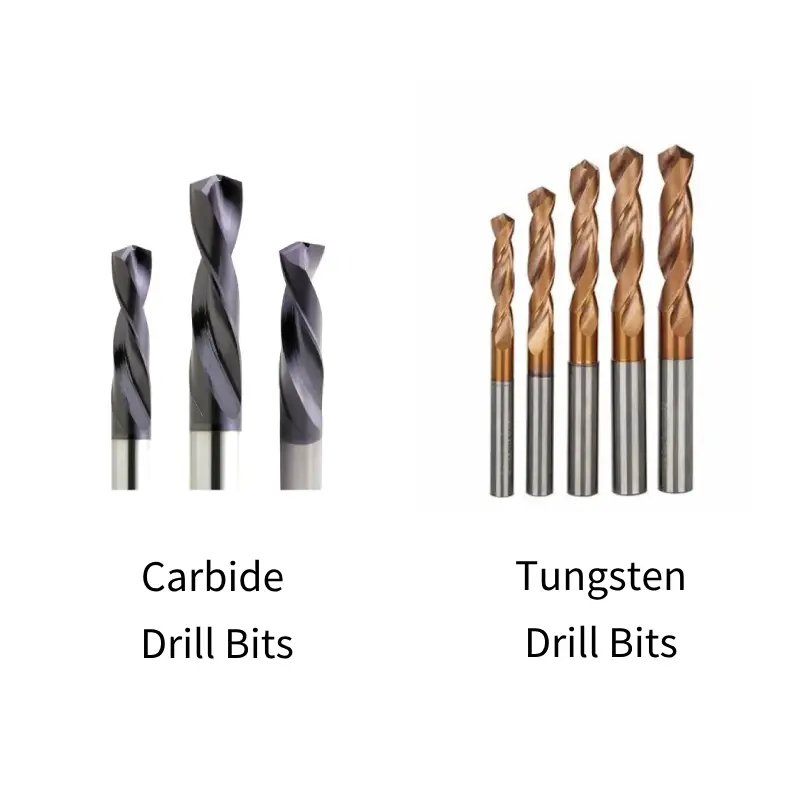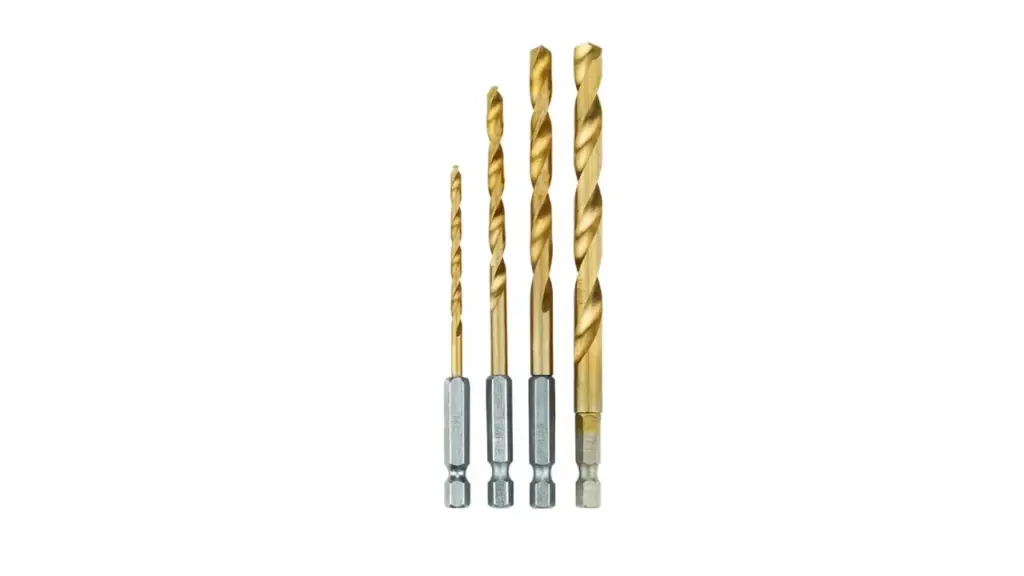When selecting drill bits, the material composition significantly impacts performance and longevity. Tungsten carbide and titanium drill bits are popular choices, each offering distinct advantages. Understanding their fundamental differences in hardness, wear resistance, and ideal applications is crucial for achieving optimal drilling results and cost-effectiveness in various projects.
This blog post will delve into a comparative analysis of tungsten carbide versus titanium drill bits. We’ll explore their unique properties, cutting capabilities on different materials, and typical applications across industries. By highlighting their strengths and weaknesses, we aim to guide you in choosing the most suitable drill bit for your specific needs.
What are Tungsten Carbide Drill Bits

Tungsten carbide drill bits are robust cutting tools crafted from a composite material of tungsten and carbon atoms, renowned for their exceptional hardness and resistance to wear and high temperatures.
This inherent strength allows them to efficiently drill through a wide spectrum of challenging materials, including various metals, tough hardwoods, abrasive composites, and even some types of masonry. Often favored over traditional steel bits in demanding applications, tungsten carbide drill bits maintain a sharp cutting edge for longer, contributing to increased productivity and tool longevity.
What are Titanium Drill Bits

Titanium drill bits typically refer to high-speed steel (HSS) drill bits that have been coated with a thin layer of titanium nitride (TiN) or titanium aluminum nitride (TiAlN). This coating significantly enhances the bit’s surface hardness, reduces friction, and increases wear resistance compared to uncoated HSS bits.
As a result, titanium-coated drill bits can maintain a sharper cutting edge for a longer period, drill faster, and generate less heat, making them a popular choice for drilling through metals, wood, and plastics. However, the core material remains HSS, so they don’t possess the extreme inherent hardness of solid tungsten carbide bits.
Tungsten Carbide vs Titanium Drill Bits

Selecting the right drill bit is crucial for efficient and effective material removal, and understanding the differences between tungsten carbide and titanium options is key. While both offer advantages over standard high-speed steel, their fundamental compositions and resulting properties lead to distinct performance characteristics and ideal applications.
Let’s explore the nuances of these two popular drill bit types to guide your selection process.
Material Composition and Manufacturing
Tungsten carbide drill bits are constructed from an extremely hard and dense composite material formed by sintering fine tungsten and carbon powders with a binder metal, typically cobalt or nickel. This process creates a bit with exceptional hardness, compressive strength, and the ability to retain its cutting edge even at high temperatures. The specific grade of carbide, determined by the grain size and binder content, can be tailored to optimize for toughness or wear resistance depending on the intended application.
Titanium drill bits, in contrast, are generally made from high-speed steel (HSS) and then coated with a thin layer of a titanium compound, most commonly titanium nitride (TiN) or titanium aluminum nitride (TiAlN). This coating significantly enhances the surface hardness, reduces friction, and improves wear resistance of the underlying HSS. The manufacturing process for the base HSS bit involves hardening and tempering steel to achieve a balance of hardness and toughness, while the subsequent coating is applied through processes like physical vapor deposition.
Hardness and Wear Resistance
Tungsten carbide possesses a significantly higher inherent hardness compared to high-speed steel, even with a titanium coating. This extreme hardness allows carbide bits to effectively cut through very hard and abrasive materials, such as hardened steels, cast iron, stainless steel, and even some ceramics, with less wear and a longer lifespan. Their ability to maintain a sharp cutting edge under demanding conditions makes them ideal for heavy-duty industrial applications.
Titanium-coated HSS bits offer a notable improvement in hardness and wear resistance over uncoated HSS bits. The titanium nitride or titanium aluminum nitride coating creates a harder surface that reduces friction and heat buildup during drilling, extending the bit’s life and allowing for faster drilling speeds in softer materials like aluminum, copper, mild steel, wood, and plastics. However, the underlying HSS is still less hard than solid tungsten carbide, making titanium-coated bits more susceptible to wear and breakage when used on extremely hard materials.
Applications and Performance
Tungsten carbide drill bits excel in applications requiring the drilling of very hard, abrasive, or high-temperature materials where longevity and consistent performance are critical. They are commonly used in machining, metalworking, mold making, and aerospace industries. While they can be more brittle than HSS, their superior hardness allows for precise and efficient material removal in demanding tasks, often at higher speeds on appropriate materials with proper cooling and technique.
Titanium-coated HSS drill bits are a popular choice for general-purpose drilling across a wide range of materials in home improvement, construction, and light industrial settings. They offer a good balance of performance, durability, and cost-effectiveness for drilling softer metals, wood, and plastics. The coating helps to extend their lifespan and improve drilling efficiency compared to uncoated HSS bits, making them a versatile option for various drilling tasks that don’t involve extremely hard materials.
Cost Considerations
Tungsten carbide drill bits are generally more expensive than titanium-coated HSS bits due to the higher cost of raw materials (tungsten) and the more complex manufacturing processes involved in creating solid carbide tools. However, their extended lifespan and superior performance on very hard materials can often lead to a lower overall cost per hole in specific industrial applications where frequent bit replacement would be necessary with less durable options.
Titanium-coated HSS drill bits offer a more affordable option for a wide range of drilling tasks. The HSS base material is less expensive than tungsten carbide, and while the titanium coating adds to the cost compared to uncoated HSS, it provides a significant improvement in performance and longevity for the price. This makes them a cost-effective choice for general-purpose use and applications that don’t involve extremely hard or highly abrasive materials.
How to Choose Tungsten Carbide and Titanium Drill Bits
Tungsten carbide drill bits are crafted from an exceptionally hard composite material, making them ideal for drilling through tough substances like hardened steel, cast iron, and even some ceramics. Their inherent strength and resistance to wear and high temperatures ensure a longer lifespan and consistent performance in demanding industrial applications. While typically more expensive upfront, their durability often provides better long-term value when working with challenging materials where other bits would quickly fail.
Titanium drill bits, commonly high-speed steel (HSS) with a titanium nitride or titanium aluminum nitride coating, offer enhanced hardness and reduced friction compared to uncoated HSS bits. This makes them a popular choice for drilling softer metals, wood, and plastics, providing improved speed and longevity over standard HSS. While not as inherently hard as solid tungsten carbide, their affordability and versatility make them suitable for a wide range of general-purpose drilling tasks.
- Material Hardness: Tungsten carbide exhibits significantly higher hardness, allowing it to cut through very hard materials that would quickly dull titanium-coated bits.
- Wear Resistance: The inherent hardness of tungsten carbide provides superior resistance to abrasion and wear, leading to a longer tool life in demanding applications.
- Heat Resistance: Tungsten carbide can withstand higher operating temperatures without losing its hardness, crucial for drilling hard materials at higher speeds.
- Application Range: Tungsten carbide excels in heavy-duty industrial drilling of tough metals and abrasive materials, while titanium-coated bits are better suited for general-purpose drilling of softer materials.
- Cost: Tungsten carbide drill bits typically have a higher initial cost due to the raw materials and manufacturing processes involved.
- Longevity (Application Dependent): While titanium-coated bits last longer than uncoated HSS for general use, tungsten carbide often provides a longer lifespan when drilling very hard materials.
Conclusion
Tungsten carbide drill bits offer superior hardness and wear resistance compared to titanium, making them ideal for demanding materials like hardened steel and cast iron. While titanium-coated bits provide enhanced durability over standard high-speed steel for general use, they don’t match the inherent strength of carbide in heavy-duty applications.
Titanium drill bits, often HSS with a titanium nitride coating, offer a good balance of performance and affordability for drilling softer metals, wood, and plastics. The coating reduces friction and increases lifespan compared to uncoated bits. However, for consistently drilling tough materials, tungsten carbide remains the more robust choice.
Ultimately, the best drill bit depends on the task. For general-purpose drilling, titanium-coated bits are a solid option. However, for tackling hard materials and demanding industrial applications, tungsten carbide’s inherent strength is essential. For wholesale drill bit needs, consider the diverse range offered by Sinodrills to match your specific requirements.


